Note to folks coming over from Giant Bomb: Hi! Thanks for visiting. You have been linked to the middle of this Metroid II series. You can start here at part one, or better yet, just go to the Anatomy of a Game page for the full rundown on this entire project, which also includes the NES Castlevania trilogy, Metroid, The Legend of Zelda, the Mario franchise, and more.
One thing I really admire about Metroid II: It has a ton of different creatures populating its world. Some biological entities native to the planet; some mechanical constructs presumably built by the vanished society responsible for all the structures and weapons you encounter. Sometimes it seems that every room you enter has a creature you’ve never encountered before, and quite a number of them occupy only a single room or two.
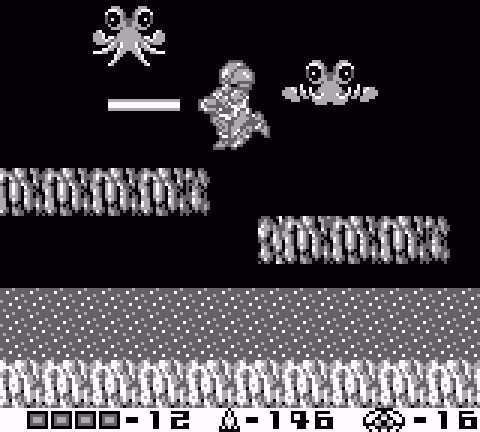
Like this planarian things that fly up and float downward. Other enemies have similar behavior, but these guys only appear in a couple of places.
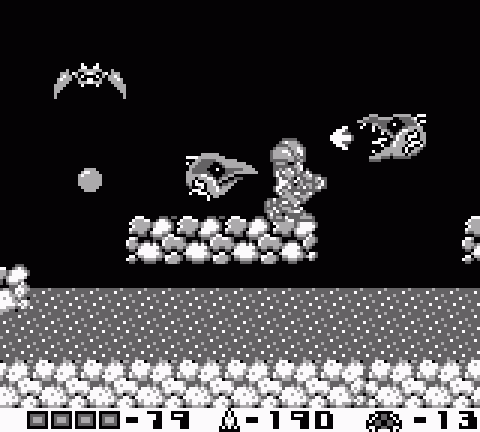
Or this one room where fanged birds rise from the lava, stop at Samus’ height, and belch a projectile. Meanwhile bats hover overhead, dropping bombs that explode upon striking the ground. Neither of these creatures appear outside of this room.
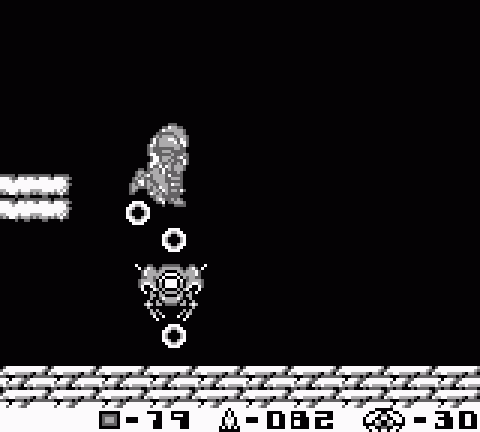
Likewise, there are certain robots that you only encounter once or twice. Now, a bunch of enemies appear repeatedly throughout the adventure, but sprinkled amidst them are what seem like dozens of enemy types that only show up in a single room.
I suppose this is something Metroid II has in common with the original game. Not the proliferation of unique enemies per se, but the common thread of straining against sharp technical limitations. For Metroid, the hindrance came from the limited storage space of the Famicom Disc System and early NES cartridges. There, it manifested in the repetitive world design and stark visual style, and the designers compensated by color-coding much of the labyrinth to provide visual clues to your current relative location.
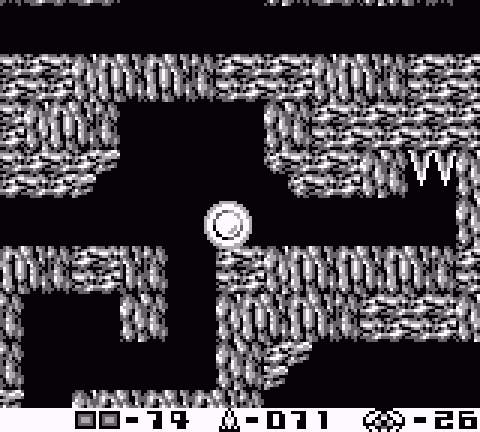
Metroid II‘s designers had far more memory space to work with — its ROM was roughly twice the size of the original’s — but no colors. So they compensated in turn by using that extra capacity to create a more diverse graphical set. Problematic as the game’s narrow field of vision and lack of color can be, you can still see a great deal of effort went into differentiating every area of the game (sometimes every screen of the game) by adding in a ton of visual variety. The environmental graphics vary from place to place, mimicking different rock formations, artificial constructs, and eventually far more alien landscapes. The weird, one-off enemies take it all a step further by giving attentive players a sort of living landmark. Metroid II would have benefitted greatly from even a simple in-game map, but failing that the approach its designers took works well enough.
Of course, Super Metroid wouldn’t have to contend with either of these issues: At 24 Mb, it was the the largest Super NES game ever made at the time.
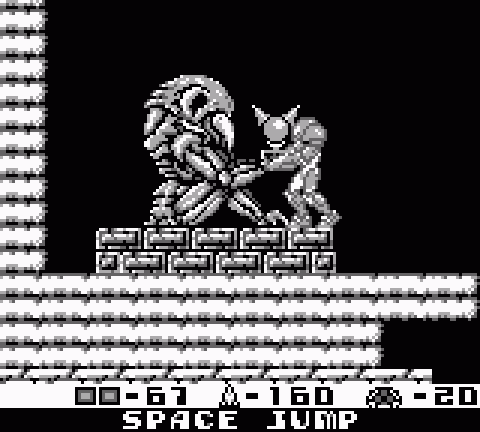
Someone mentioned in the comments yesterday that they played through Metroid II without ever encountering the Spring Ball and never felt like they missed anything. And that’s a reasonable enough impression. Most of the gear Samus collects throughout her adventure here is wholly optional; in fact, if I’m not mistaken, the only items you absolutely have to collect are the Spider Ball, the Bomb, and the Space Jump. The Space Jump shows up about halfway through the game, in the third cavern/pocket of SR-388. At this point, you can hunt down the remaining metroids and beat the game. Anything else you collect is just gravy. The concept of a tightly crafted environment in which nothing is superfluous and progress resembles a puzzle is still a year away as of 1991, but A Link to the Past will break that ground soon enough.
The Space Jump is entirely new to Metroid II — the original double jump, and then some. It allows Samus to “fly,” effectively, by performing infinite leaps. It has its limitations; you have to spin jump to activate it (a standing jump won’t work), you have to chain a new jump near the apex of the previous one, and if you hit something in midair (like, say, a ceiling), you’ll probably break your chain. Still, with a little practice, it’s an incredibly powerful skill… and a brave one. Between the Spider Ball and Space Jump, Metroid II literally lets you go anywhere. Most designers would recoil in terror at the thought of giving the player such freedom.
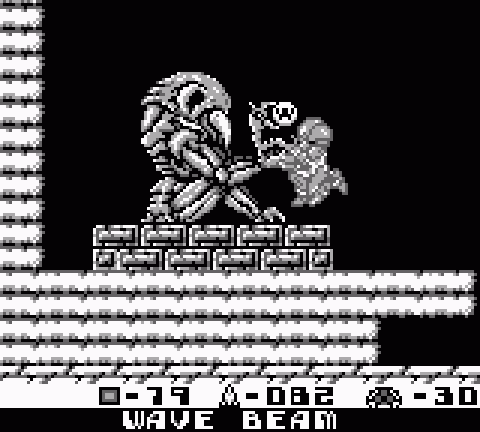
Pleasantly optional this time around — especially once you find the Space Jump — is the Ice Beam. In the original Metroid, only the obstinate would elect to go battle-spelunking while using the Wave Beam. Sure, it was more powerful than the Ice Beam, but it greatly hindered navigation. Freezing enemies allowed you to use them as platforms to new heights, greatly facilitating your exploration of Zebes.
Here, however, the Ice Beam is more of a detriment than anything. It has a narrow field of fire and low stopping power. Well, “stopping power” in the figurative sense; it still freezes enemies in their tracks, even when doing so violates the laws of physics. This proves to be vastly less useful in Metroid II than in any other game of the series, however, because (1) you gain new traversal skills so rapidly and (2) once again, that narrow field of vision. The tactical advantage of freezing monsters is greatly diminished when you see so little of them.
But that’s fine, because Metroid II offers a wealth of other combat options. There’s the Wave Beam, which works exactly the same as the one in the original game…
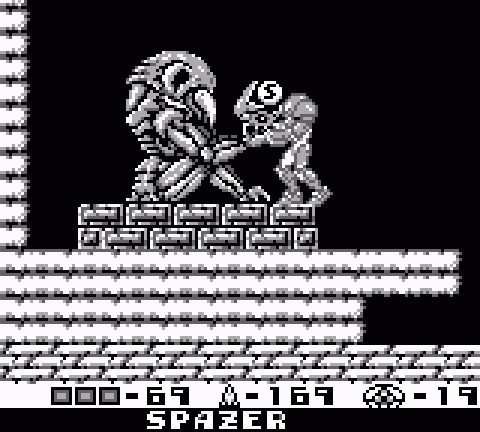
…and you can also elect to equip Samus instead with the Spazer (a triple beam with an effective spread similar to the Wave Beam, but without the gaps caused by Wave Beam’s sine pattern) or the Plasma Beam (a long but very narrow piercing shot that requires precision but hits several times harder than any other beam). Eventually, you will need the Ice Beam again, but the game is kind enough to provide when the time comes. Until then, you can experiment with other forms of firepower.
Of course, it’s an either-or proposition here. Combining beams is still a sequel away.
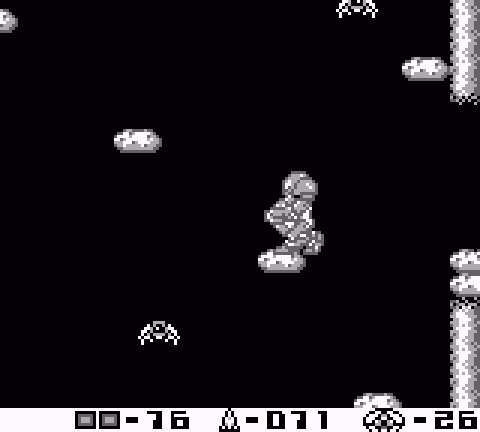
Unfortunately, the third area of the game is a real chore to explore until you get the Space Jump. It consists primarily of vertical shafts dotted by tiny, tiny platforms. Endless vertical corridors bookended the original Metroid, of course , with one at the beginning and another at the very end. Here, they show up in the middle of the game, and while none of them are as taxing as the ones in Metroid, they still irritate. Most of them utilize the small footholds of Metroid‘s escape sequence; in the previous game, they existed to make that final dash to safety harrowing. Here, they’re irritating for no real reason.
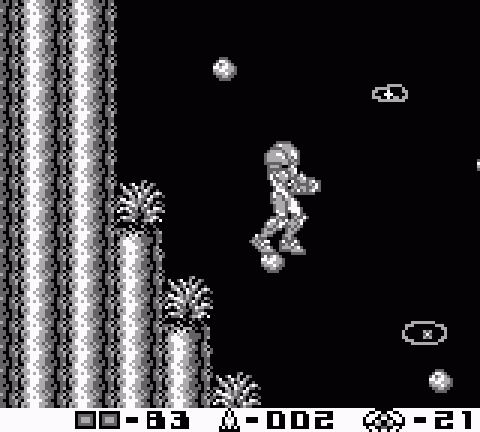
This isn’t a difficult portion of the game, so being forced to jump onto platforms barely large enough to hold Samus just comes off as hostile design for the sake of being obnoxious. It wouldn’t be so bad if this one area (with hazardous plants lining the bottom of the shaft) were the only instance of this, but the entire area is like this — and if you miss a jump, you’ll very likely plummet all the way to the bottom since the close-in camera angle shows very little of what’s below Samus and makes it harder to maneuver her to a platform as she falls. And, as mentioned before, the field of vision makes climbing tougher, too, since you can leap higher than you can see (and often must, here), which always puts you at risk of jumping into an unseen threat. Of course, leaping into an enemy will cause Samus to recoil up and away, quite likely making you drop to the bottom of the shaft again.
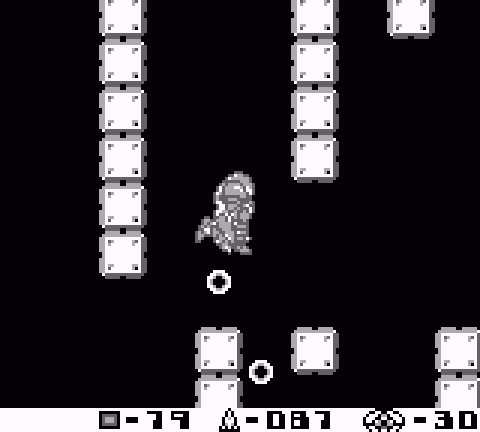
The Space Jump somewhat eases the tedium of this area, but even then it has its shortcomings. For one, the Metroid II version of Space Jump requires very precise control compared to its appearance in later games.
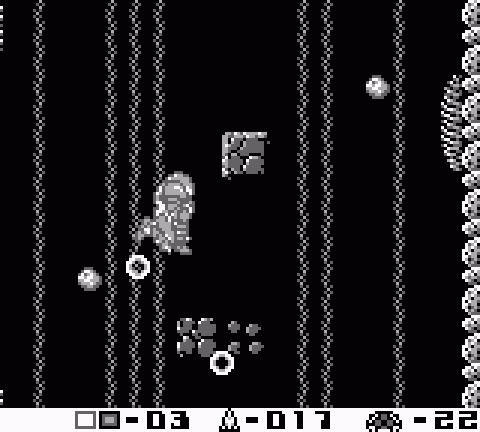
And two, the Screw Attack doesn’t show up until the fourth phase, so you’re very vulnerable as you make your ascent… which doesn’t really make it that much more advantageous than simply jumping up the platforms.
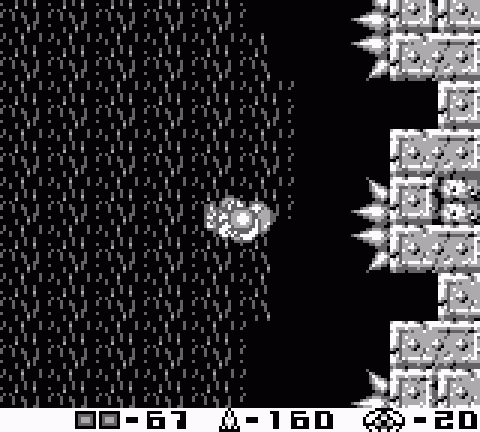
And then occasionally the game just gets nasty.
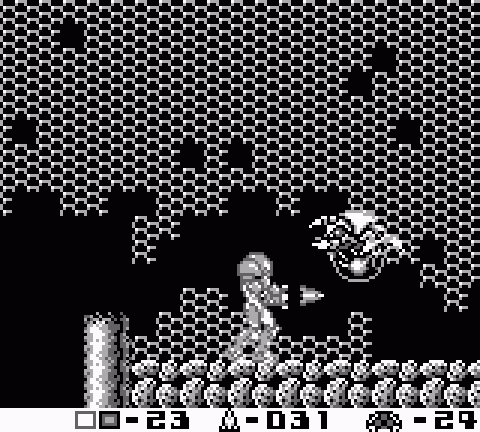
The Metroid encounters in phase three become considerably trickier. Alphas and gammas behave the same as ever, but now you’ll frequently encounter them in rooms where environmental elements obstruct your shots. Here, for example, Samus and the metroid can move freely through the mesh, but what appears to be a background detail can be shot away… which means that if you shoot at the metroid while it’s behind the mesh, you’ll destroy a portion of the mesh instead. Several metroids also appear in rooms filled with sand blocks, spawning inside the sand, which means you have to shoot away all of that clutter to get a clear shot.
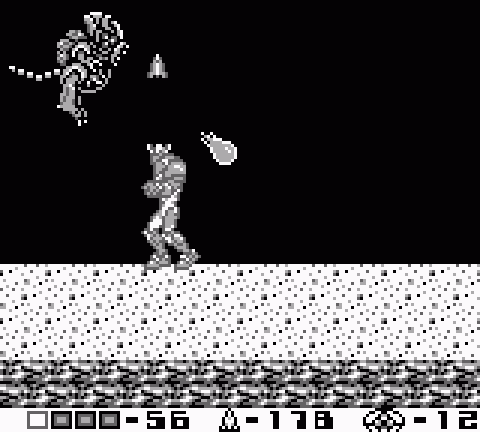
And it just wouldn’t be a new phase of the game without a new metroid type to go along with it. The zeta metroid mutates from the gamma type, and it’s quite a radical transformation. Gone is any insectile/crustacean appearance, replaced by a fully bipedal monster that flies around like a xenomorph with a rocket pack. It can no longer attack with static discharge, instead belching fireballs at you.
Most of the zeta metroid’s body is invulnerable. Its head and belly are weak, and if you can slip behind it to fire at the TMNT shell on its back you’ll inflict extra damage. But it’s much harder to shoot from below, and because it rises to hover and attack from above, you’re forced to jump to keep it in your sights. The zeta metroid goes down after 20 missiles — twice as many as the gamma. (Yes, there’s a pattern to this.) It hits a little harder than its lower-ranking brethren, but moves slowly enough that it doesn’t pose too much of a threat.
Never has the series’ desire to be Aliens been so obvious as in the design of this dude.
Your point about the enemy variety reminds me of the games original manual. Not only did it include a name and description for every single enemy, but they also included the character art, which was much more refined from the original Metroid. All of the art in there is pretty great, and I still have a copy even though that was long before I made an effort to keep game boxes or manuals.
@Discord_Inc: “All of the art in there is pretty great” - Amen.
The space jumping against a mostly black background can become a little disorienting and even made me feel kind of dizzy a times. Those were the only moments I was wishing for bigger viewing field, but it is only a minor hurdle.
I like the fact that you can acquire so many power ups rather early on, so that you are invited to explore freely, using your preferred tools. It seems to me that A Link Between Worlds gets praise for doing more or less the same thing (least on a basic level).
I am not sure Metroid 2 would benefit from a map function. That actually might make navigation and exploration too easy and less rewarding. As mentioned in the article, enviroment and enemies can serve as landmarks. The same can be said about audio cues as well: Once you are back in the main shaft, you can tell immediately by the heroic, forward-pushing theme. On the other hand the “levels” themselves are divided into “outside” and “inside” areas. “Outside” areas are generally a bit wider, and are introduced with a short, music-halting jingle, suggesting to the player to carefully look around for hazards and possible routes to take. Merely sparse, subdued and irregular atmospheric noise is heard (aside from actual sound fx). The enviroments themselves become the focal point of attention. They almost seem to breathe and, as a result, appear bigger than they actually are.
Inside the buildings a rather somber and a liitle odd sounding music track is played, featuring smaller pauses and the occasional change of pace. Usually these sections are where you have to do the most thinking to find secrets and power ups.
Those kinds of associations are quickly learned by the player and the combination of visaul and auditive information really helps memorizing and recognizing the surroundings.
I hadn´t noticed how not only the Spring Ball but all the other power ups besides the three you mention were actually optional… Even the Varia Suit is there just to make things a bit easier, but there is no environmental hazard that requires this extra protection to advance, unlike the sequel. Your deep analysis is showing this game has an even more unique design approach than it was already apparent.
Also, I agree with Jama in the comment above about the map. It wasn´t really necessary to include such a feature in a game where backtracking is not only not required, but almost discouraged. But the most important element that would be hampered by an automap would be the feeling of being lost in the lonely and dark bowels of an hostile but almost completely deserted alien planet.
This game relies so much in the lingering feeling of dread it can leave on the player with its atmosphere, its sounds, its overall creepiness, that it must have been the designers deliberate claim to fame for this project. This isn´t at all the most fun to play game in the Game Boy library, but those of us who completed it in our childhood on the old green screen will never forget it, even if the desire to play it again, even after 20 years, is non existent, at least in my case. But it made an experience for the ages.
As they said in the Gamepro review that convinced me to get the game, “No other Game Boy cart can grab and hold your imagination like Metroid 2” And at that moment in time that was absolutely true.
I wouldn’t want a map in Metroid II to show me where to go. But it would be incredibly useful to help keep track of where you’ve been. It’s easy to overlook a passage when they all look so similar.
That´s true, and with the help of a map I wouldn´t have missed the Spring Ball… Even from a conceptual point of view Samus would still be alone and mostly lost in the cavernous depths of that planet even if her suit had some form of rudimentary GPS to keep track of where she had been.
But back in those days players were used to be left to their own sense of orientation… Many excellent, complex games like Blaster Master for example, were sorely lacking a map (and a save feature in that particular case)
As you point out, (and I hadn´t noticed, even though I surely benefited from it) the producers of Metroid 2 even went the extra mile to put unique enemies as a sort of landmark to help with this problem, instead of providing a mapping device. Maybe this apparent no in-game map policy was a conspiracy to boost the sales of Nintendo Power?
Luckily three years later the sequel would address that issue in such a trend setting way!